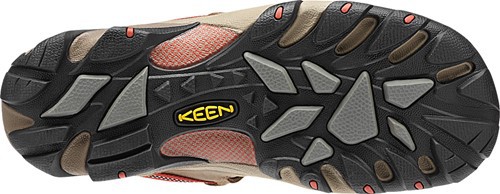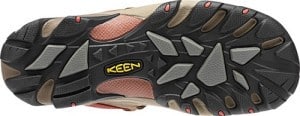Sneakers and runners are one of the best choices (for light weight – but bear in mind foot PROTECTION) providing they will not puncture too readily from below (or from the side) and (IF – check!) they are still light when they are wet and they are not too narrow in the toes (because when going downhill, if they are, life will become a MISERY! You MAY need half sizes (wider) as I do, but many stores don’t carry them or pretend they don’t exist. Many shoes will MORE than double in weight when they are wet, and some of the hiking sneakers pump water in and out with each step in such a way that you still have the weight but also a shoefull of very cold water all the time. They may even pinch the nerves at the base of your big toes and create an aching numbness which will last for weeks!)
Shoes MUST GRIP ON WET ROCKS, wet leaves and sticks. Almost nothing does – and you can only find out by trying. If they don’t, you WILL have a nasty fall, often straight on to the back of your neck: Ouch! In my opinion the makers of most hiking shoes should be SHOT! I am yet to find a Vibram sole which will grip on anything in wet bush, and I will never again buy any boots which have them. Some of the light leather (soft toe) work boots are good, practical and economic choices. Blundstones and Redbacks, for example. They HAVE to be lace-ups as you will roll around mercilessly in pull-ons, and your feet will KILL you! The basic models of both brands absorb very little water in my experience (only 50-100 grams per shoe) – but the manufacturers are always working at making their shoes worse! They have decided to fill in the space in front of the heel for example – so you can no longer ‘dig your heels in’ when going downhill; if you do you will notice they have chamfered the back of the heel so they ‘assist’ you in falling hard on your back when you do! I used to wear only Highmark ‘GP’s’ for years when suddenly they became unwearable to me, similarly Rossi hiking boots – but they MAY work well for YOU.
With leather boots it is a good idea to fill them with water for a few days and have them sitting in the sun on the verandah, then when you are about to go on a hike of a couple of hours or so, tip out the water and put them on. This will mould them to your feet like slippers. Old hands use to urinate in their new boots and leave them stand to soften. This may work even better! Afterwards, when they dry out again, you will have to dubbin them up again to resoften the leather. At the moment I have been wearing some nice wide Keen Targhees shoes (which have a good protective rubber toe). They have been quite comfortable for me, but the grip on the sole does not last long. At my weight, the shoes are failing after a few weeks’ walking, at most. Still, I would rather throw away a pair of shoes after a week if that’s how long they gripped well (but I had a good time in them while they lasted) than repeat some other of the footwear disasters I have experienced. I spiked a pair of very light New Balance for example with a tree root as thick as your thumb right in the centre of my foot, and a LONG way from home! Fortunately I was OK, but you don’t want to repeat this ‘experiment’!
Who would have believed a hiking/running shoe which weighs less than 200 grams? http://www.inov-8.com/Products.asp?PG=PG1&L=26 and these people have a river crossing shoe which weighs 53 grams: http://www.sprintaquatics.com/prodinfo.asp?number=901
Foot care is very important: YOUR FEET are what are going to get you there AND out of there, but more importantly are what is going to ensure you have a good time, especially if you are a foot fetishist! Sore feet are NO FUN! You should prepare your feet for a long walk ahead of time. If you suffer from dry feet (and cracking of the heels, etc) you need to copiously apply ‘heel balm’ (there are many brands) at least once a day eg before you put your socks on in the mornings until your feet are just like babies’ feet. I would recommend this anyway. During your hike you should reapply it every morning to ensure that your feet are soft and well lubricated. This will help to prevent blisters (which you should NEVER SUFFER FROM!) You can decant enough into small containers such as are sold by Coughlin’s – useful also for insect repellent, sun screen, hand cream, toothpaste etc. Gossamer Gear also sell micro dripper bottles which are very useful for small quantities of various liquids. A small tube or quantity of anti-fungal cream is a medical essential. If you contract tinea on a long walk it will quickly make your life a misery unless you have something to eradicate it. BEWARE: it can also strike in the crutch region (as can chafing – hand cream here at the beginning of the day is a good idea). Cut your toenails VERY short about ten days before your hike. This will make the flesh under the front of them quite tender for a few days before it toughens up (This is part of the idea!). Then, the day before the hike, file them back again so that the toenails do not protrude more than the flesh of your toes. It is the flesh of your toes which should encounter your shoes, NOT your toenails. BE WARNED! One of the worst problems you will encounter on a long hike (mainly caused by down-hilling) is the toenails striking the fronts of your shoes and being driven back into the roots and quicks. This will quickly cause them to blacken, become very sore and they WILL FALL OUT. It IS AGONY! Avoid this at all costs! It is ONE reason why I look for wider shoes. Blisters are another VERY unpleasant experience. As a preventative wear a pair of lightweight wicking liner socks (such as are sold by Wigwam – makers of some excellent socks!) They WILL help to prevent blisters as they move relative to your shoes and your socks, eliminating some of the friction. Take plenty of Band-Aid ‘Blister Pads’ (two sizes) and apply them the INSTANT you start to get a hot spot. They will stay on for days and really DO prevent blisters. You should have already chosen shoes which do NOT move against your feet and create friction. If you haven’t experimented extensively with your shoes before a multi-day hike you are a goose! A roll of Leucotape is AN ESSENTIAL. About ¾” inch is good. You have NO IDEA how many people I have seen on hikes whose feet resemble some nightmare from Flanders’ Fields. Be Warned! Or be VERY SORRY!
Sandals are well named (if not well-spelled). They certainly DO fill up with sand and grit so that you have to stop frequently to empty them out (a more arduous task for me these days because of my arthritis) but they ARE much cooler for walking in hot weather. My personal choice are these Keen Newport H2s. (Della seems happy with her couple of pairs too): http://www.keenfootwear.com/us/en/product/shoes/men/waterfront/newport%20h2 I have weighed the Newports (422g) and the Arroyo 2 (411g) each (in US size 9). Probably the Arroyo IS a better trail sandal:
SOCKS: I have found Wigwam brand very good over the years, and liner socks are VERY important (especially if wearing boots rather than sneakers) as already mentioned, but they ARE pretty dear: there is nothing wrong with the old-fashioned ‘Holeproof’ brand: Heroes (summer – and as liner socks!) and Explorers (winter). I just bought some online from Harris Scarfe. To protect yourself from leeches, tuck the ends of your trousers into your socks. I NEVER wear gaiters: they will just add unnecessary weight to your feet, and remember: Every pound on your feet equals about TEN pounds on your back!
GAITERS: If you MUST have gaiters, (a mental deficiency I have never understood) get some ultralight ones, eg from Mountain Laurel Designs: Super Light Gaiters @ 50 grams per pair: http://www.mountainlaureldesigns.com/shop/product_info.php?cPath=37&products_id=114 These are great too, waterproof/breathable rain mitts for when it is VERY cold. Surprising how unpleasant frozen hands really are. You really don’t need much insulation: just keep them dry. These weigh 35 grams per pair: http://www.mountainlaureldesigns.com/shop/product_info.php?cPath=24&products_id=51 Zpacks makes something similar out of cuben – and even lighter, (from 27 grams per pair!)
Just to lighten up a bit, you might want to bookmark this one. Knots are very handy and this site shows how to tie them easily. There MAY be a hangman’s noose there as well, which could be handy in this political climate: http://www.animatedknots.com/



Thank you. I found this very helpful. I knew some of this but I learned something knew as well. I also like the links as now I will check out their products. My feet do like the keen shoes as the toe box is roomy! There’s an old saying: Happy wife Happy life. I like Happy feet Life is sweet! May your toes stay pink and dry!
Thank You Regina. Hope you find some other useful things on my site/s. Can I recommend you check out: http://www.finnsheep.com/HIKING.htm too?
Agree with everything you said on foot care!
Thanks – hope you like some of my other posts too. You can like my page on Facebook to get updates.